Managing Water Level for Large Migratory Fish at the Poyang Lake Outlet: Implications Based on Habitat Suitability and Connectivity
Abstract
:1. Introduction
2. Materials and Methods
2.1. Study Area and Procedures
2.2. Data Acquisition and Preprocessing
2.2.1. Field Data and Hydroacoustic Survey
2.2.2. Lake Bathymetry Simulation
2.2.3. Hydrological Data and the Three-Dimensional Hydrodynamic Simulation
2.3. Calculation of the WUA and HC
2.4. Error Source Analysis and Accuracy Validation
3. Results
3.1. Fishery Resources
3.2. Habitat Suitability Index Curves
3.3. Effects of Water Level on the WUA and HC
3.4. Mapping the Graded Habitat Suitability and the ECA Distribution
4. Discussion
4.1. The Habitat Suitability Index
4.2. Effects of Hydrologic Changes on the WUA and HC
4.3. Implications for Management and Conservation
4.3.1. Adjusting Reservoir Management
4.3.2. Conservation Area and Recommendations
4.4. Data Limitations and Innovations
5. Conclusions
Supplementary Materials
Author Contributions
Funding
Institutional Review Board Statement
Informed Consent Statement
Conflicts of Interest
Abbreviations
References
- Agostinho, A.A.; Gomes, L.C.; Verissimo, S.; Okada, E.K. Flood regime, dam regulation and fish in the Upper Parana River: Effects on assemblage attributes, reproduction and recruitment. Rev. Fish Biol. Fish. 2004, 14, 11–19. [Google Scholar] [CrossRef]
- Amoros, C.; Bornette, G. Connectivity and biocomplexity in waterbodies of riverine floodplains. Freshw. Biol. 2002, 47, 761–776. [Google Scholar] [CrossRef]
- Fuller, I.C.; Death, R.G. The science of connected ecosystems: What is the role of catchment-scale connectivity for healthy river ecology? Land Degrad. Dev. 2018, 29, 1413–1426. [Google Scholar] [CrossRef]
- Reis, R.E.; Albert, J.S.; Di Dario, F.; Mincarone, M.M.; Petry, P.; Rocha, L.A. Fish biodiversity and conservation in South America. J. Fish Biol. 2016, 89, 12–47. [Google Scholar] [CrossRef] [Green Version]
- Grill, G.; Lehner, B.; Thieme, M.; Geenen, B.; Tickner, D.; Antonelli, F.; Babu, S.; Borrelli, P.; Cheng, L.; Crochetiere, H.; et al. Mapping the world’s free-flowing rivers. Nature 2019, 569, 215, Erratum in Nature 2019, 572, E9. [Google Scholar] [CrossRef]
- Graf, W.L. Dam nation: A geographic census of American dams and their large-scale hydrologic impacts. Water Resour. Res. 1999, 35, 1305–1311. [Google Scholar] [CrossRef]
- Vitousek, P.M.; Mooney, H.A.; Lubchenco, J.; Melillo, J.M. Human domination of Earth’s ecosystems. Science 1997, 277, 494–499. [Google Scholar] [CrossRef] [Green Version]
- Waldman, M.; Shevah, Y. Biological diversity—An overview. Water Air Soil Pollut. 2000, 123, 299–310. [Google Scholar] [CrossRef]
- Barbarossa, V.; Schmitt, R.J.P.; Huijbregts, M.A.J.; Zarfl, C.; King, H.; Schipper, A.M. Impacts of current and future large dams on the geographic range connectivity of freshwater fish worldwide. Proc. Natl. Acad. Sci. USA 2020, 117, 3648–3655. [Google Scholar] [CrossRef] [Green Version]
- Wang, H.Z.; Liu, X.Q.; Wang, H.J. The Yangtze River Floodplain: Threats and Rehabilitation. In Proceedings of the 1st Mississippi-Yangtze River Basin Symposium at the 143rd American-Fisheries-Society Annual Meeting, Little Rock, AR, USA, 8–12 September 2013; pp. 263–291. [Google Scholar]
- Liu, X.Q.; Wang, H.Z. Effects of loss of lateral hydrological connectivity on fish functional diversity. Conserv. Biol. 2018, 32, 1336–1345. [Google Scholar] [CrossRef]
- Yang, J.; Yan, D.; Yang, Q.J.; Gong, S.H.; Shi, Z.M.; Qiu, Q.J.; Huang, S.L.; Zhou, S.F.; Hu, M.L. Fish species composition, distribution and community structure in the Fuhe River Basin, Jiangxi Province, China. Glob. Ecol. Conserv. 2021, 27, e01559. [Google Scholar] [CrossRef]
- Huang, L.L.; Wu, Z.Q.; Li, J.H. Fish fauna, biogeography and conservation of freshwater fish in Poyang Lake Basin, China. Environ. Biol. Fishes 2013, 96, 1229–1243. [Google Scholar] [CrossRef]
- Lin, M.L.; Chen, S.B.; Gozlan, R.E.; Ren, P.; Li, W.; Ye, S.W.; Wang, Q.D.; Zhang, T.L.; Liu, J.S.; Li, S.H.; et al. Stock enhancement of Culter mongolicus: Assessment of growth, recapture and release size in the Yangtze lakes. Fish. Res. 2021, 234, 105809. [Google Scholar] [CrossRef]
- Aharon-Rotman, Y.; McEvoy, J.; Zhaoju, Z.; Yu, H.; Wang, X.; Si, Y.L.; Xu, Z.G.; Yuan, Z.; Jeong, W.; Cao, L.; et al. Water level affects availability of optimal feeding habitats for threatened migratory waterbirds. Ecol. Evol. 2017, 7, 10440–10450. [Google Scholar] [CrossRef] [PubMed]
- Wu, H.P.; Zeng, G.M.; Liang, J.; Chen, J.; Xu, J.J.; Dai, J.; Sang, L.H.; Li, X.D.; Ye, S.J. Responses of landscape pattern of China’s two largest freshwater lakes to early dry season after the impoundment of Three-Gorges Dam. Int. J. Appl. Earth Obs. Geoinf. 2017, 56, 36–43. [Google Scholar] [CrossRef]
- Zhang, H.; Jaric, I.; Roberts, D.L.; He, Y.F.; Du, H.; Wu, J.M.; Wang, C.Y.; Wei, Q.W. Extinction of one of the world’s largest freshwater fishes: Lessons for conserving the endangered Yangtze fauna. Sci. Total Environ. 2020, 710, 136242. [Google Scholar] [CrossRef]
- Yi, Y.J.; Yang, Z.F.; Zhang, S.H. Ecological influence of dam construction and river-lake connectivity on migration fish habitat in the Yangtze River basin, China. In Proceedings of the Biennial International Conference on Ecological Informatics and Ecosystem Conservation (ISEIS), Beijing, China, 27–29 August 2010; pp. 1942–1954. [Google Scholar]
- Feng, L.; Han, X.X.; Hu, C.M.; Chen, X.L. Four decades of wetland changes of the largest freshwater lake in China: Possible linkage to the Three Gorges Dam? Remote Sens. Environ. 2016, 176, 43–55. [Google Scholar] [CrossRef]
- Godlewska, M.; Colon, M.; Doroszczyk, L.; Dlugoszewski, B.; Verges, C.; Guillard, J. Hydroacoustic measurements at two frequencies: 70 and 120 kHz—Consequences for fish stock estimation. Fish. Res. 2009, 96, 11–16. [Google Scholar] [CrossRef]
- Wang, C.Y.; Wei, Q.W.; Kynard, B.; Du, H.; Zhang, H. Migrations and movements of adult Chinese sturgeon Acipenser sinensis in the Yangtze River, China. J. Fish Biol. 2012, 81, 696–713. [Google Scholar] [CrossRef]
- Nagaya, T.; Shiraishi, Y.; Onitsuka, K.; Higashino, M.; Takami, T.; Otsuka, N.; Akiyama, J.; Ozeki, H. Evaluation of suitable hydraulic conditions for spawning of ayu with horizontal 2D numerical simulation and PHABSIM. Ecol. Model. 2008, 215, 133–143. [Google Scholar] [CrossRef]
- Bylak, A.; Kukula, K.; Plesiński, K.; Radecki-Pawlik, A. Effect of a baffled chute on stream habitat conditions and biological communities. Ecol. Eng. 2017, 106, 263–272. [Google Scholar] [CrossRef]
- Plesiński, K.; Bylak, A.; Radecki-Pawlik, A.; Mikołajczyk, T.; Kukuła, K. Possibilities of fish passage through the block ramp: Model-based estimation of permeability. Sci. Total Environ. 2018, 631–632, 1201–1211. [Google Scholar] [CrossRef] [PubMed]
- Li, Y.L.; Zhang, Q.; Cai, Y.J.; Tan, Z.Q.; Wu, H.W.; Liu, X.G.; Yao, J. Hydrodynamic investigation of surface hydrological connectivity and its effects on the water quality of seasonal lakes: Insights from a complex floodplain setting (Poyang Lake, China). Sci. Total Environ. 2019, 660, 245–259. [Google Scholar] [CrossRef] [PubMed]
- Randall, D.; Brauner, C. Effects of Environmental Factors on Exercise in Fish. J. Exp. Biol. 1991, 160, 113–126. [Google Scholar] [CrossRef]
- Lian, Y.X.; Huang, G.; Godlewska, M.; Cai, X.W.; Li, C.; Ye, S.W.; Liu, J.S.; Li, Z.J. Hydroacoustic estimates of fish biomass and spatial distributions in shallow lakes. J. Oceanol. Limnol. 2018, 36, 587–597. [Google Scholar] [CrossRef]
- Zhang, H.; Wang, C.Y.; Yang, D.G.; Du, H.; Wei, Q.W.; Kang, M. Spatial distribution and habitat choice of adult Chinese sturgeon (Acipenser sinensis Gray, 1835) downstream of Gezhouba Dam, Yangtze River, China. J. Appl. Ichthyol. 2014, 30, 1483–1491. [Google Scholar] [CrossRef]
- Yi, Y.J.; Wang, Z.Y.; Lu, Y.J. Habitat suitability index model for Chinese Sturgeon in the Yangtze River. Adv. Water Sci. 2007, 18, 538–543. [Google Scholar] [CrossRef]
- Clark, J.S.; Rizzo, D.M.; Watzin, M.C.; Hession, W.C. Spatial distribution and geomorphic condition of fish habitat in streams: An analysis using hydraulic modelling and geostatistics. River Res. Appl. 2008, 24, 885–899. [Google Scholar] [CrossRef]
- Dronova, I.; Beissinger, S.R.; Burnham, J.W.; Gong, P. Landscape-Level Associations of Wintering Waterbird Diversity and Abundance from Remotely Sensed Wetland Characteristics of Poyang Lake. Remote Sens. 2016, 8, 462. [Google Scholar] [CrossRef] [Green Version]
- Xu, G.; Qin, Z.J. Flood Estimation Methods for Poyang Lake Area. J. Lake Sci. 1998, 10, 31–36. [Google Scholar] [CrossRef] [Green Version]
- Feng, L.; Hu, C.M.; Chen, X.L.; Zhao, X. Dramatic Inundation Changes of China’s Two Largest Freshwater Lakes Linked to the Three Gorges Dam. Environ. Sci. Technol. 2013, 47, 9628–9634. [Google Scholar] [CrossRef] [PubMed]
- Dai, Z.; Du, J.; Li, J.; Li, W.; Chen, J. Runoff characteristics of the Changjiang River during 2006: Effect of extreme drought and the impounding of the Three Gorges Dam. Geophys. Res. Lett. 2008, 35. [Google Scholar] [CrossRef]
- Chen, Y.Y. Fauna Sinica. Osteichthyes, Cypriniformes II; Science Press: Beijing, China, 1998. (In Chinese) [Google Scholar]
- Zhou, L.; Zeng, L.; Fu, D.; Xu, P.; Zeng, S.; Tang, Q.; Chen, Q.; Chen, L.; Li, G. Fish density increases from the upper to lower parts of the Pearl River Delta, China, and is influenced by tide, chlorophyll-a, water transparency, and water depth. Aquat. Ecol. 2016, 50, 59–74. [Google Scholar] [CrossRef]
- Aglen, A.J.F.F.R. Random errors of acoustic fish abundance estimates in relation to the survey grid density applied. FAO Fish. Rep. 1983, 300, 293–298. [Google Scholar]
- Guillard, J.; Verges, C. The repeatability of fish biomass and size distribution estimates obtained by hydroacoustic surveys using various sampling strategies and statistical analyses. Int. Rev. Hydrobiol. 2007, 92, 605–617. [Google Scholar] [CrossRef]
- Goldberg, C.S.; Waits, L.P. Using habitat models to determine conservation priorities for pond-breeding amphibians in a privately-owned landscape of northern Idaho, USA. Biol. Conserv. 2009, 142, 1096–1104. [Google Scholar] [CrossRef]
- Frouzova, J.; Kubecka, J.; Balk, H.; Frouz, J. Target strength of some European fish species and its dependence on fish body parameters. Fish Res. 2005, 75, 86–96. [Google Scholar] [CrossRef]
- Li, H.F.; Cao, K.; Wang, D.Q.; Ding, F.; Mao, Z.H.; Yu, L.X.; Chen, D.Q.; Wang, L. Habitat suitability analysis of fish community in the channel connecting the Poyang Lake and the Yangtze River in winter. J. Fish. Sci. China 2022, 29, 341–354. (In Chinese) [Google Scholar]
- Feng, L.; Hu, C.; Chen, X.; Li, R.; Tian, L.; Murch, B. MODIS observations of the bottom topography and its inter-annual variability of Poyang Lake. Remote Sens. Environ. 2011, 115, 2729–2741. [Google Scholar] [CrossRef]
- Feng, L.; Hu, C.M.; Chen, X.L.; Cai, X.B.; Tian, L.Q.; Gan, W.X. Assessment of inundation changes of Poyang Lake using MODIS observations between 2000 and 2010. Remote Sens. Environ. 2012, 121, 80–92. [Google Scholar] [CrossRef]
- Jones, J. Habitat Selection Studies in Avian Ecology: A Critical Review. Auk 2001, 118, 557–562. [Google Scholar] [CrossRef]
- Ahmadi-Nedushan, B.; St-Hilaire, A.; Berube, M.; Robichaud, E.; Thiemonge, N.; Bobee, B. A review of statistical methods for the evaluation of aquatic habitat suitability for instream flow assessment. River Res. Appl. 2006, 22, 503–523. [Google Scholar] [CrossRef]
- Vinagre, C.; Fonseca, V.; Cabral, H.; Costa, M.J. Habitat suitability index models for the juvenile soles, Solea solea and Solea senegalensis, in the Tagus estuary: Defining variables for species management. Fish. Res. 2006, 82, 140–149. [Google Scholar] [CrossRef]
- Li, W.M.; Chen, Q.W.; Cai, D.S.; Li, R.N. Determination of an appropriate ecological hydrograph for a rare fish species using an improved fish habitat suitability model introducing landscape ecology index. Ecol. Model. 2015, 311, 31–38. [Google Scholar] [CrossRef]
- Yao, Y.; Cheng, T.; Sun, Z.; Dongsheng Chen, L.; Chen, Z.; Wei, J.; Guan, Q. VecLI: A framework for calculating vector landscape indices considering landscape fragmentation. Environ. Model. Softw. 2022, 149, 105325. [Google Scholar] [CrossRef]
- Plesinski, K.; Gibbins, C.N.; Radecki-Pawlik, A. Effects of interlocked carpet ramps on upstream movement of brown trout Salmo trutta in an upland stream. J. Ecohydraulics 2020, 5, 3–30. [Google Scholar] [CrossRef]
- Duan, X.-B.; Yu, L.-X.; Luo, H.-W.; Wang, K.; Chen, D.-Q.; Liu, S.-P. Critical Swimming Speed Comparison of Four Species of Fish at Two Acclimation Temperature. Chin. J. Zool. 2015, 50, 529–536. [Google Scholar]
- Xian, X.M.; Cao, Z.D.; Fu, S.J. The comparison of critical swimming speed and endurance at high speed of four species of juvenile fish. J. Chongqing Norm. Univ. 2010, 27, 16–20. [Google Scholar]
- Ostrovsky, I. Hydroacoustic assessment of fish abundance in the presence of gas bubbles. Limnol. Oceanogr. Methods 2009, 7, 309–318. [Google Scholar] [CrossRef]
- Wu, G.F.; Cui, L.J.; Duan, H.T.; Fei, T.; Liu, Y.L. An approach for developing Landsat-5 TM-based retrieval models of suspended particulate matter concentration with the assistance of MODIS. Isprs J. Photogramm. Remote Sens. 2013, 85, 84–92. [Google Scholar] [CrossRef]
- Moir, H.J.; Pasternack, G.B. Relationships between mesoscale morphological units, stream hydraulics and Chinook salmon (Oncorhynchus tshawytscha) spawning habitat on the Lower Yuba River, California. Geomorphology 2008, 100, 527–548. [Google Scholar] [CrossRef]
- Ye, S.; Lin, M.; Li, L.; Liu, J.; Song, L.; Li, Z. Abundance and spatial variability of invasive fishes related to environmental factors in a eutrophic Yunnan Plateau Lake, Lake Dianchi, southwestern China. Environ. Biol. Fishes 2015, 98, 209–224. [Google Scholar] [CrossRef]
- Poff, N.L.; Zimmerman, J.K.H. Ecological responses to altered flow regimes: A literature review to inform the science and management of environmental flows. Freshw. Biol. 2010, 55, 194–205. [Google Scholar] [CrossRef]
- Yu, L.X.; Lin, J.Q.; Chen, D.Q.; Duan, X.B.; Peng, Q.D.; Liu, S.P. Ecological Flow Assessment to Improve the Spawning Habitat for the Four Major Species of Carp of the Yangtze River: A Study on Habitat Suitability Based on Ultrasonic Telemetry. Water 2018, 10, 600. [Google Scholar] [CrossRef] [Green Version]
- Lian, Y.; Ye, S.; Godlewska, M.; Huang, G.; Wang, J.; Chen, S.; Zhao, X.; Du, X.; Liu, J.; Li, Z.J. Diurnal, seasonal and inter-annual variability of fish density and distribution in the Three Gorges Reservoir (China) assessed with hydroacoustics. Limnologica 2017, 63, 97–106. [Google Scholar] [CrossRef]
- Xia, S.; Liu, Y.; Wang, Y.; Chen, B.; Jia, Y.; Liu, G.; Yu, X.; Wen, L. Wintering waterbirds in a large river floodplain: Hydrological connectivity is the key for reconciling development and conservation. Sci. Total Environ. 2016, 573, 645–660. [Google Scholar] [CrossRef]
- Liu, X.; Teubner, K.; Chen, Y.W. Water quality characteristics of Poyang Lake, China, in response to changes in the water level. Hydrol. Res. 2016, 47, 238–248. [Google Scholar] [CrossRef]
- Yang, S.R.; Gao, X.; Li, M.Z.; Ma, B.S.; Liu, H.Z. Interannual variations of the fish assemblage in the transitional zone of the Three Gorges Reservoir: Persistence and stability. Environ. Biol. Fishes 2012, 93, 295–304. [Google Scholar] [CrossRef]
- Shi, L.; Jia, Y.; Zuo, A.; Ma, T.; Lei, J.; Lei, G.; Wen, L. Dynamic change of vegetation cover and productivity of Poyang Lake wetland based on MODIS EVI time series. Biodivers. Sci. 2018, 26, 828–837. [Google Scholar] [CrossRef]
- Covino, T. Hydrologic connectivity as a framework for understanding biogeochemical flux through watersheds and along fluvial networks. Geomorphology 2017, 277, 133–144. [Google Scholar] [CrossRef]
- Penha, J.; Landeiro, V.L.; Ortega, J.C.G.; Mateus, L. Interchange between flooding and drying, and spatial connectivity control the fish metacommunity structure in lakes of the Pantanal wetland. Hydrobiologia 2017, 797, 115–126. [Google Scholar] [CrossRef]
- Shao, X.; Fang, Y.; Jawitz, J.W.; Yan, J.; Cui, B. River network connectivity and fish diversity. Sci. Total Environ. 2019, 689, 21–30. [Google Scholar] [CrossRef] [PubMed]
- Li, Y.K.; Qian, F.W.; Silbernagel, J.; Larson, H. Community structure, abundance variation and population trends of waterbirds in relation to water level fluctuation in Poyang Lake. J. Great Lakes Res. 2019, 45, 976–985. [Google Scholar] [CrossRef]
- Wang, H.Z.; Liu, X.Q.; Wang, H.J. The Yangtze River Floodplain: Threats and Rehabilitation. In Fishery Resources, Environment, and Conservation in the Mississippi and Yangtze (Changjiang) River Basins; The American Fisheries Society: Bethesda, MD, USA, 2016. [Google Scholar]
- Wu, Z.S.; Zhang, D.W.; Cai, Y.J.; Wang, X.L.; Zhang, L.; Chen, Y.W. Water quality assessment based on the water quality index method in Lake Poyang: The largest freshwater lake in China. Sci. Rep. 2017, 7, 17999. [Google Scholar] [CrossRef] [PubMed]
- Guo, C.; Ye, S.; Lek, S.; Liu, J.; Zhang, T.; Yuan, J.; Li, Z.J.E.M. The need for improved fishery management in a shallow macrophytic lake in the Yangtze River basin: Evidence from the food web structure and ecosystem analysis. Ecol. Model. 2013, 267, 138–147. [Google Scholar] [CrossRef]
- Ye, S.; Li, Z.; Zhang, T.; Liu, J.; Xie, S. Assessing fish distribution and threats to fish biodiversity in the Yangtze River Basin, China. Ichthyol. Res. 2014, 61, 183–188. [Google Scholar] [CrossRef]
- Armitage, A.R.; Jensen, S.M.; Yoon, J.E.; Ambrose, R.F. Wintering shorebird assemblages and behavior in restored tidal wetlands in southern California. Restor. Ecol. 2007, 15, 139–148. [Google Scholar] [CrossRef]



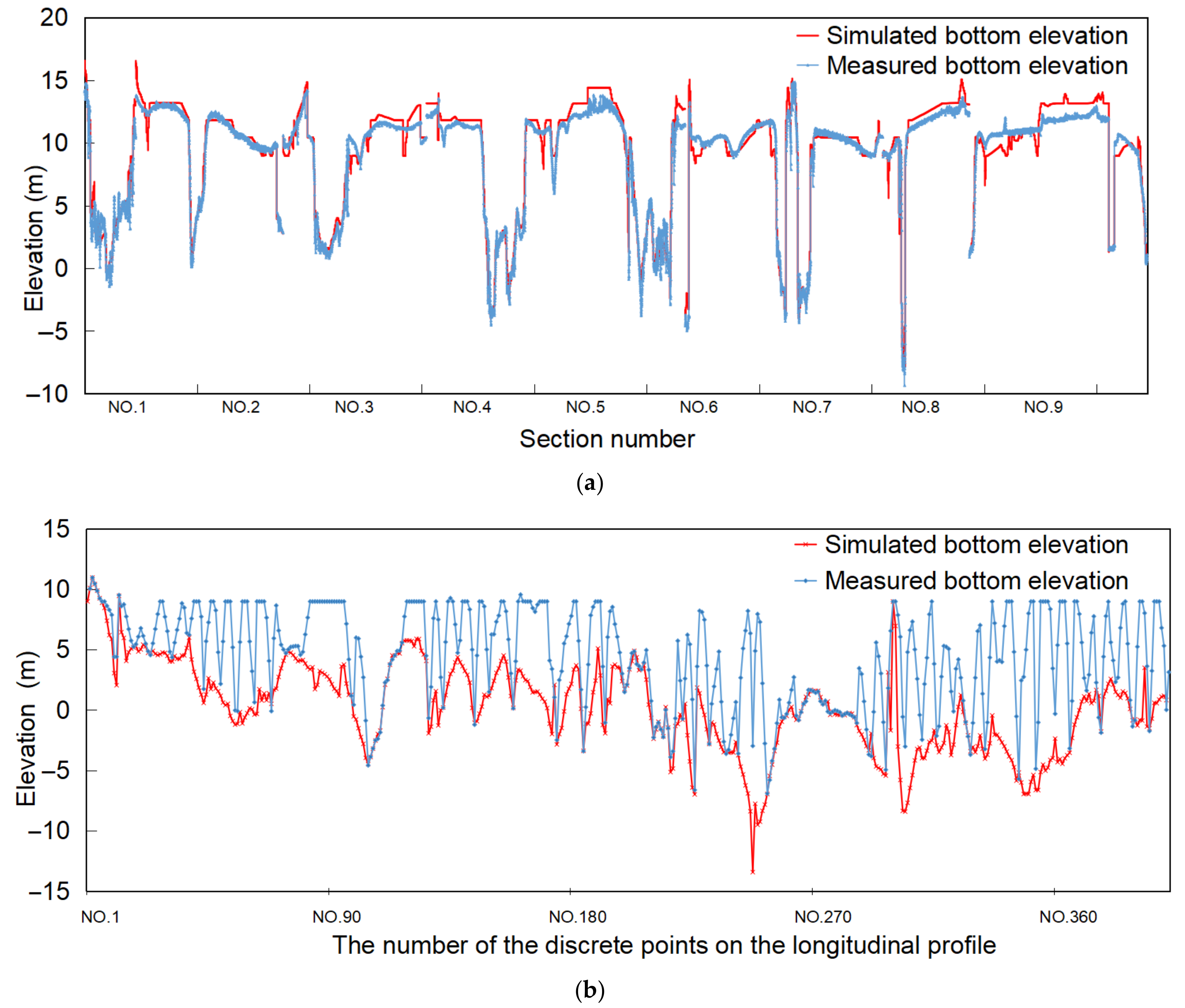
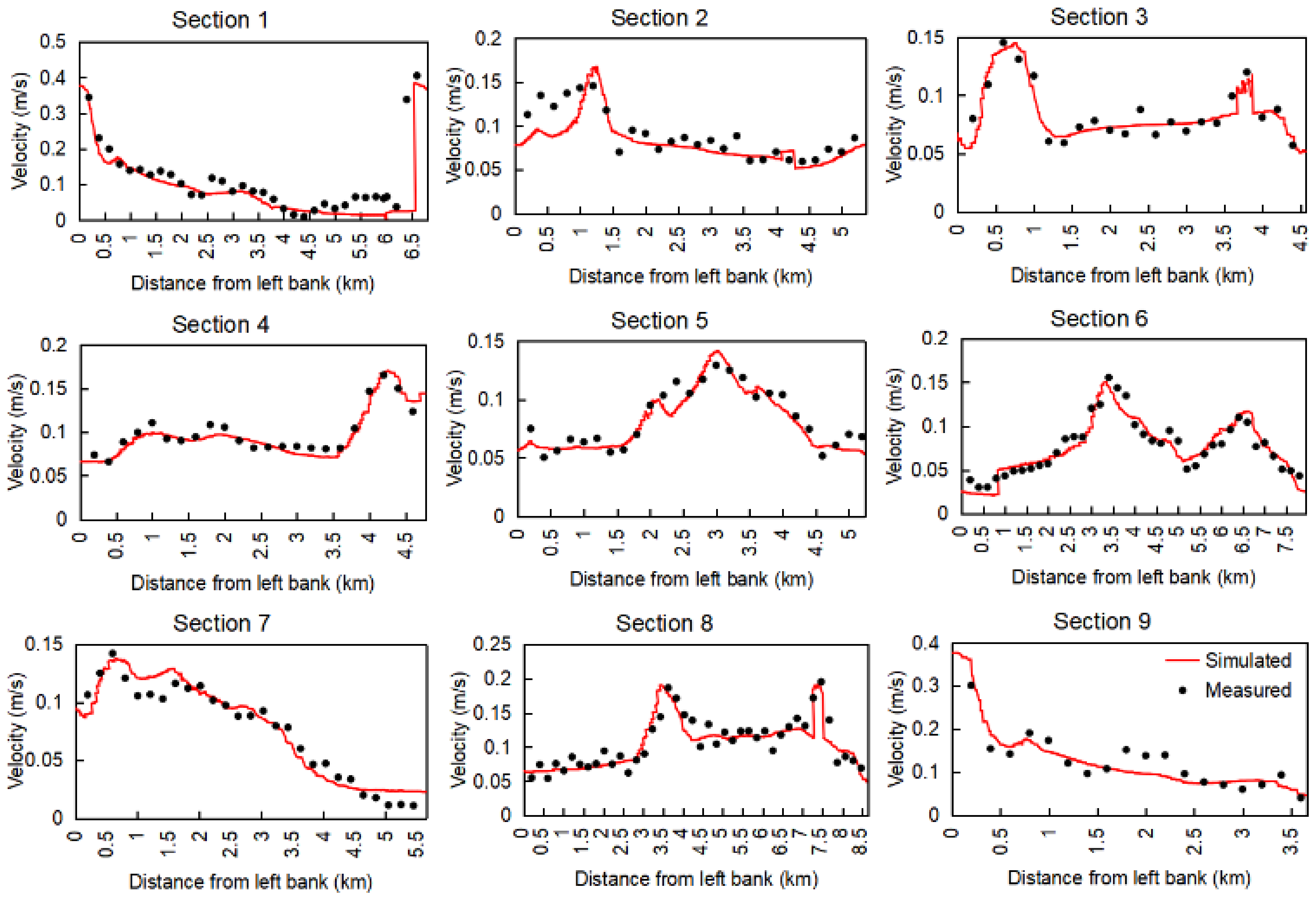


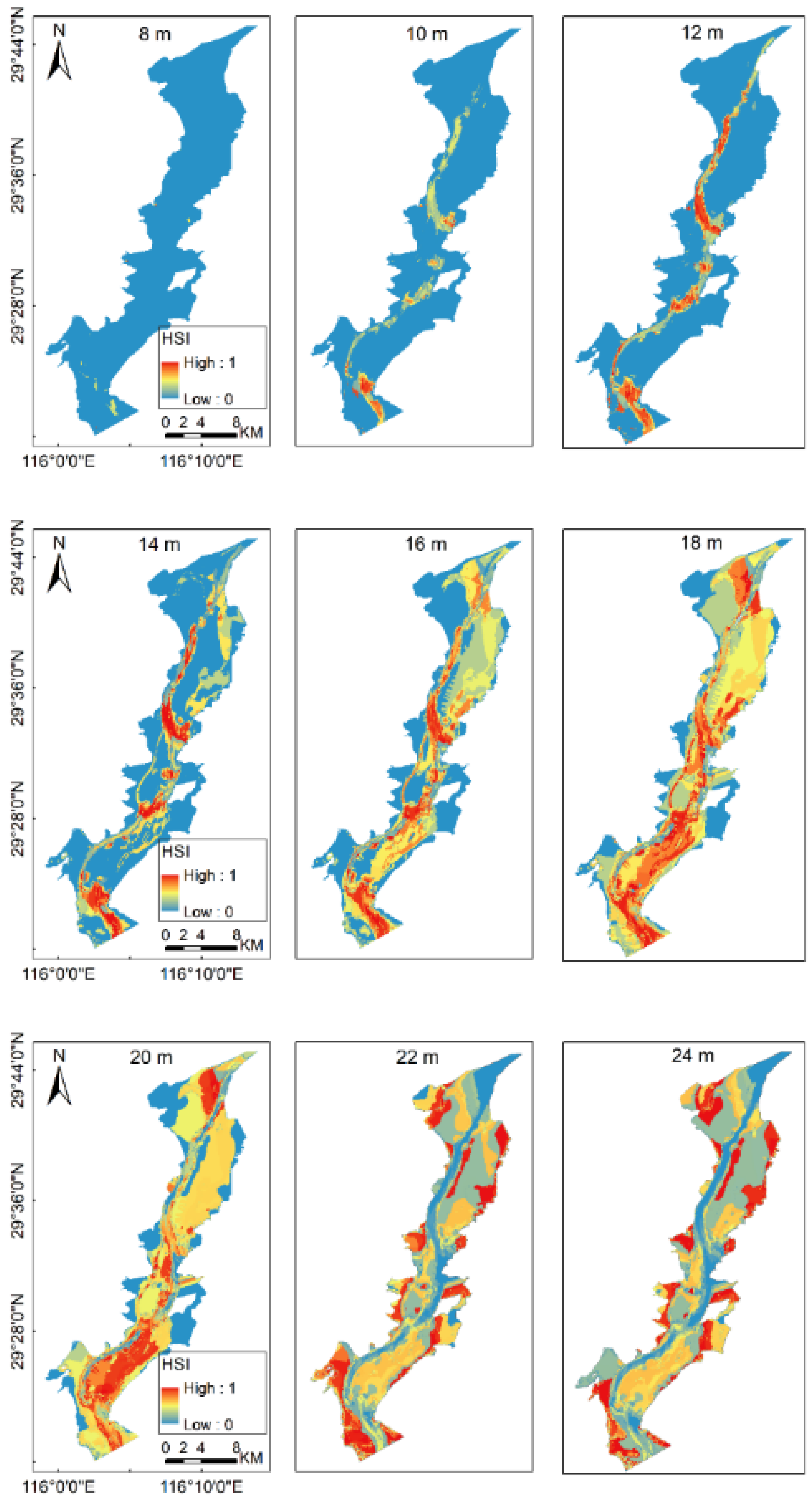
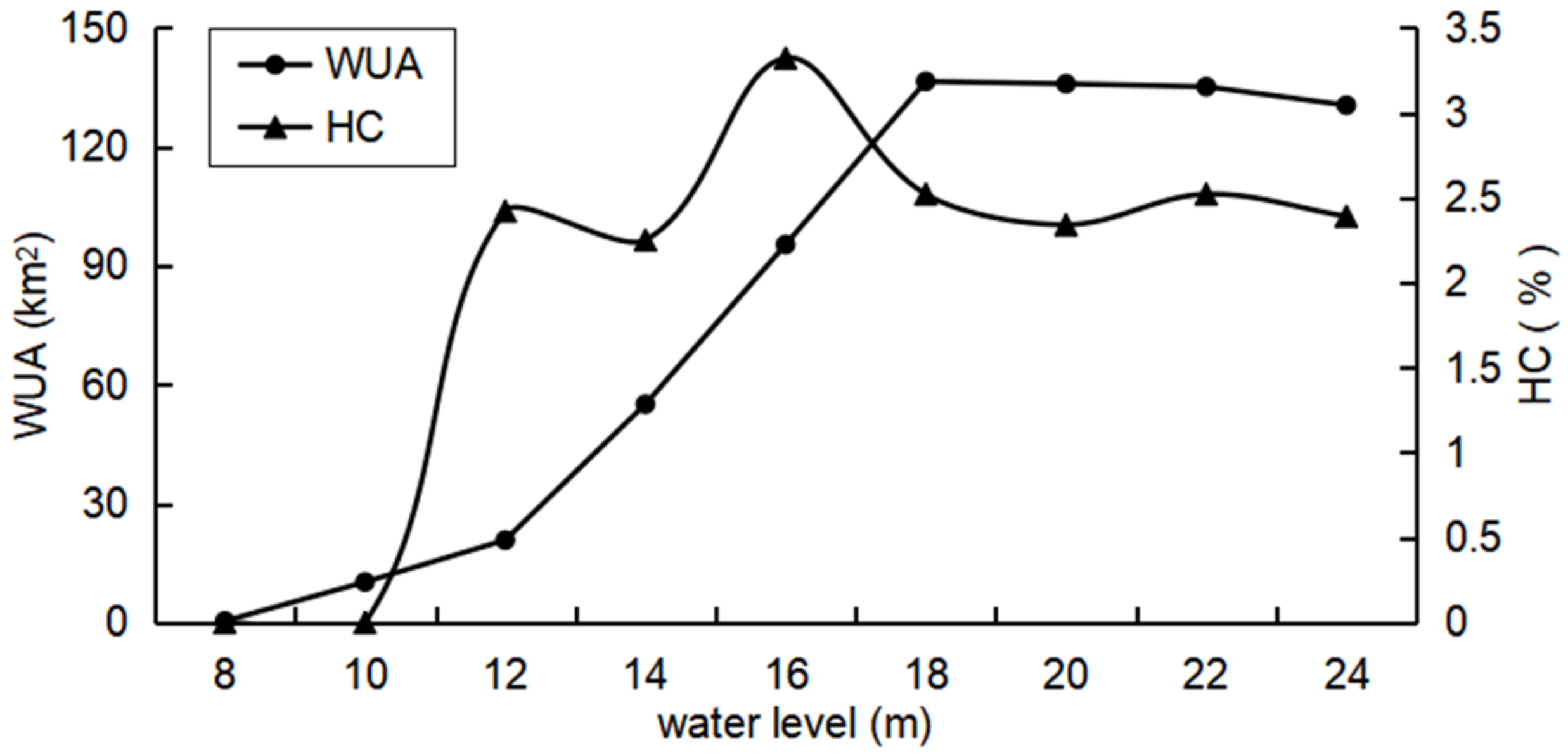

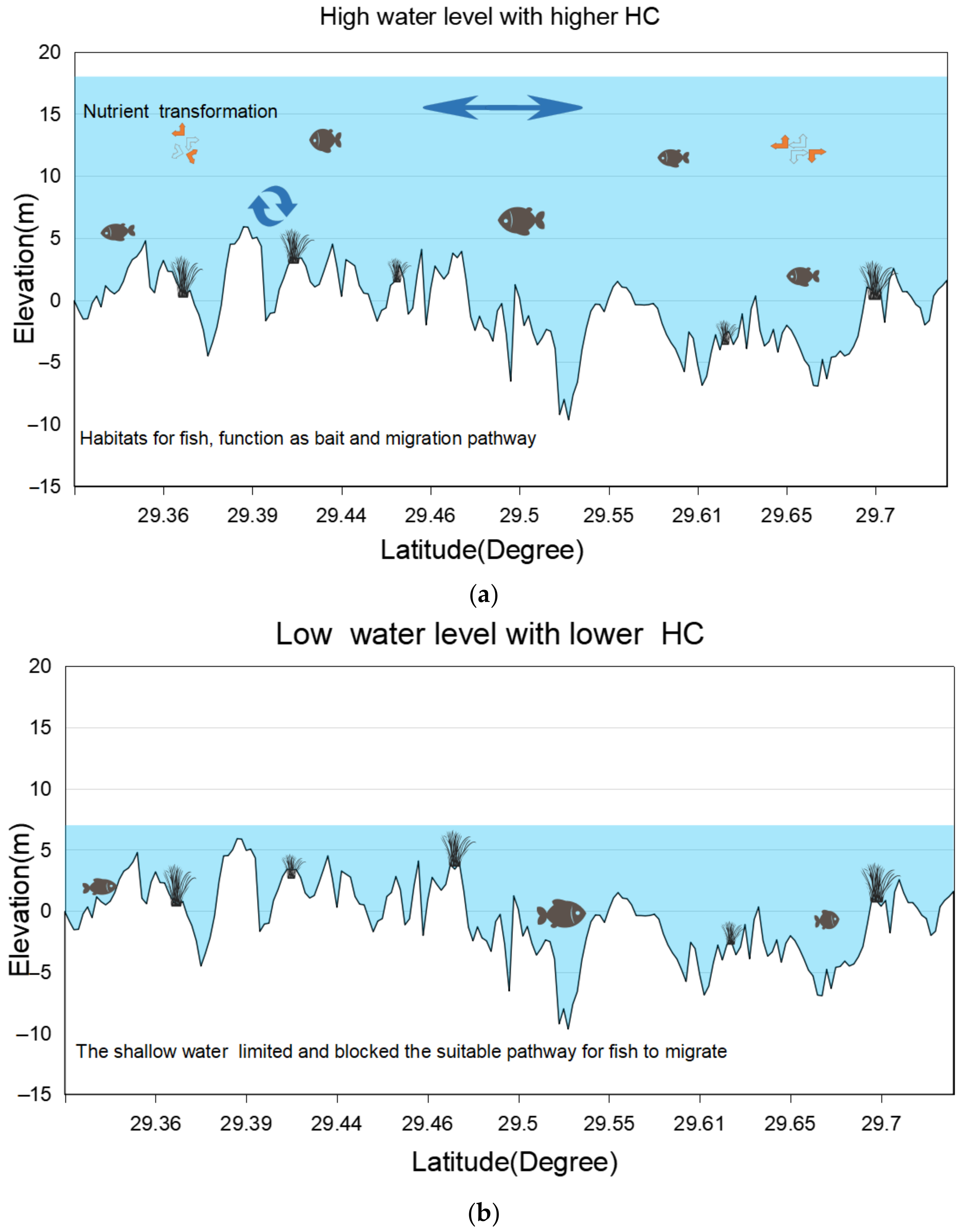
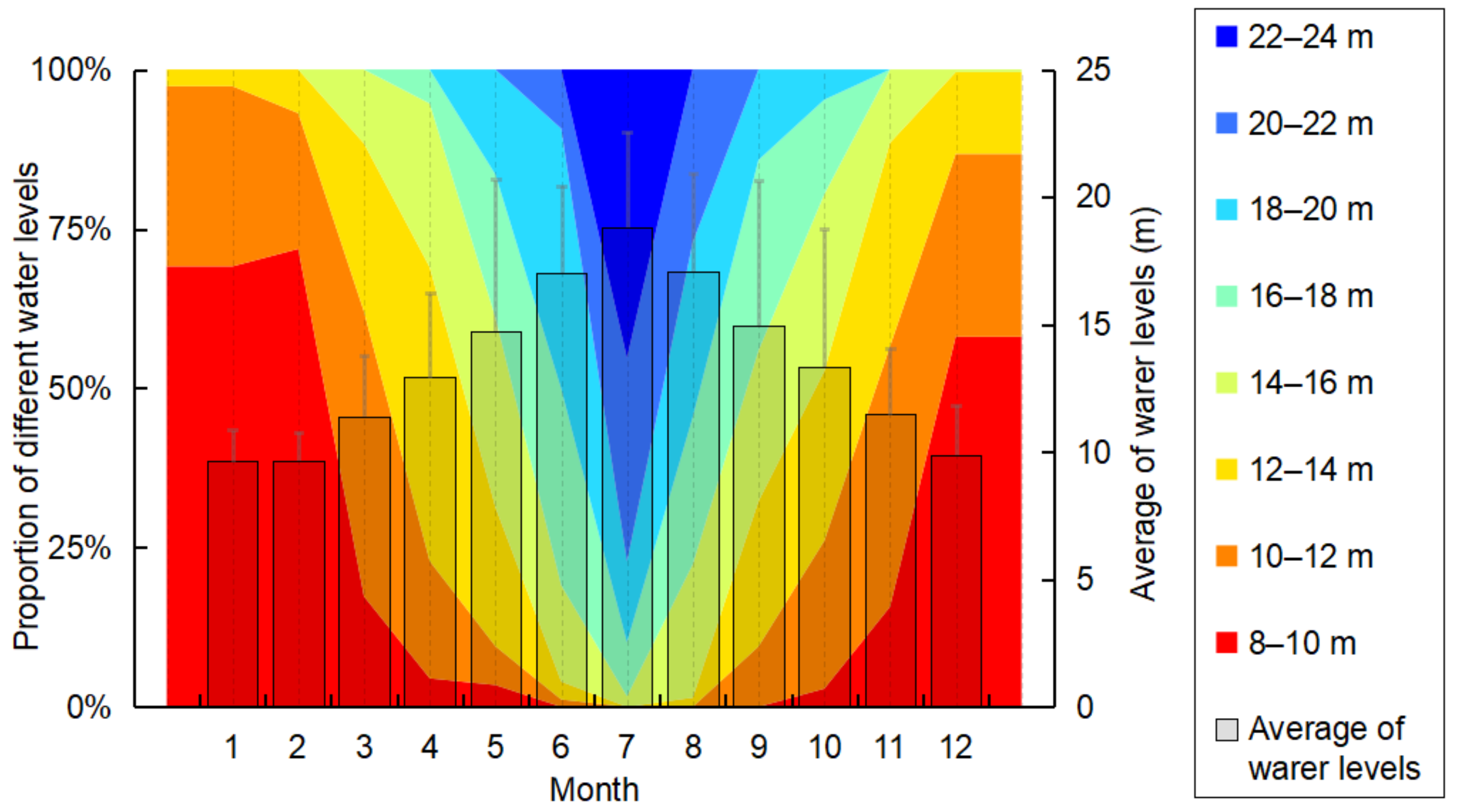
| Typical Period | X (°) | Y (°) | Total Fish Length (mm) | Depth (m) | Velocity (m/s) | Slope (°) |
|---|---|---|---|---|---|---|
| L | 116.186768 | 29.71343 | 509.9 | 5.68 | 0.221 | 0.24 |
| L | 116.186676 | 29.713238 | 523.6 | 5.84 | 0.221 | 0.41 |
| L | 116.193474 | 29.729624 | 613.8 | 6.51 | 0.262 | 0.49 |
| L | 116.186592 | 29.71254 | 730.3 | 6.58 | 0.222 | 0.15 |
| L | 116.188126 | 29.713003 | 729.5 | 6.6 | 0.232 | 0.24 |
| L | 116.193474 | 29.72966 | 572.1 | 6.78 | 0.261 | 0.51 |
| L | 116.195076 | 29.724415 | 607.4 | 6.84 | 0.291 | 3.59 |
| L | 116.193481 | 29.72954 | 603.3 | 6.87 | 0.26 | 0.42 |
| L | 116.178177 | 29.693518 | 531.5 | 6.92 | 0.161 | 0.73 |
| L | 116.147034 | 29.627581 | 549.5 | 7.03 | 0.117 | 0.43 |
| L | 116.193489 | 29.729496 | 571.5 | 7.03 | 0.26 | 0.53 |
| L | 116.194023 | 29.73019 | 742.2 | 7.03 | 0.281 | 0.93 |
| L | 116.193558 | 29.729301 | 868 | 7.8 | 0.259 | 1.65 |
| L | 116.194168 | 29.730278 | 534.6 | 7.97 | 0.284 | 1.64 |
| L | 116.06662 | 29.450401 | 497.2 | 7.99 | 0.19 | 6.24 |
| L | 116.06665 | 29.450409 | 850.2 | 7.99 | 0.193 | 6.24 |
| L | 116.12249 | 29.581728 | 723.6 | 8.03 | 0.124 | 0.28 |
| L | 116.1866 | 29.712501 | 453.4 | 8.17 | 0.222 | 0.11 |
| L | 116.193748 | 29.728872 | 848.2 | 8.53 | 0.269 | 1.65 |
| L | 116.193748 | 29.728872 | 1022.1 | 8.53 | 0.269 | 1.65 |
| L | 116.19577 | 29.731487 | 1347.4 | 9.26 | 0.367 | 1.18 |
Publisher’s Note: MDPI stays neutral with regard to jurisdictional claims in published maps and institutional affiliations. |
© 2022 by the authors. Licensee MDPI, Basel, Switzerland. This article is an open access article distributed under the terms and conditions of the Creative Commons Attribution (CC BY) license (https://creativecommons.org/licenses/by/4.0/).
Share and Cite
Li, H.; Zhang, H.; Yu, L.; Cao, K.; Wang, D.; Duan, X.; Ding, F.; Mao, Z.; Wang, K.; Liu, S.; et al. Managing Water Level for Large Migratory Fish at the Poyang Lake Outlet: Implications Based on Habitat Suitability and Connectivity. Water 2022, 14, 2076. https://doi.org/10.3390/w14132076
Li H, Zhang H, Yu L, Cao K, Wang D, Duan X, Ding F, Mao Z, Wang K, Liu S, et al. Managing Water Level for Large Migratory Fish at the Poyang Lake Outlet: Implications Based on Habitat Suitability and Connectivity. Water. 2022; 14(13):2076. https://doi.org/10.3390/w14132076
Chicago/Turabian StyleLi, Huifeng, Hui Zhang, Lixiong Yu, Kun Cao, Dengqiang Wang, Xinbin Duan, Fang Ding, Zhihui Mao, Ke Wang, Shaoping Liu, and et al. 2022. "Managing Water Level for Large Migratory Fish at the Poyang Lake Outlet: Implications Based on Habitat Suitability and Connectivity" Water 14, no. 13: 2076. https://doi.org/10.3390/w14132076
APA StyleLi, H., Zhang, H., Yu, L., Cao, K., Wang, D., Duan, X., Ding, F., Mao, Z., Wang, K., Liu, S., Wang, S., Chen, D., & Wang, L. (2022). Managing Water Level for Large Migratory Fish at the Poyang Lake Outlet: Implications Based on Habitat Suitability and Connectivity. Water, 14(13), 2076. https://doi.org/10.3390/w14132076






